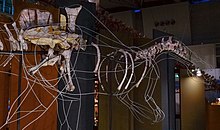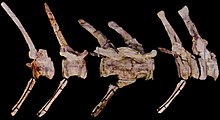Ichthyovenator
| Ichthyovenator | |
|---|---|

| |
| Mounted holotype skeleton at the National Museum of Nature and Science, Tokyo | |
| Scientific classification | |
| Domain: | Eukaryota |
| Kingdom: | Animalia |
| Phylum: | Chordata |
| Clade: | Dinosauria |
| Clade: | Saurischia |
| Clade: | Theropoda |
| Family: | †Spinosauridae |
| Subfamily: | † Spinosaurinae
|
| Genus: | †Ichthyovenator Allain et al., 2012 |
| Type species | |
| †Ichthyovenator laosensis Allain et al., 2012
| |
Ichthyovenator is a
The holotype specimen is estimated to have been between 8.5 to 10.5 metres (28 to 34 feet) long and to have weighed 2.4
As a spinosaur, Ichthyovenator would have had a long, shallow snout and robust forelimbs. Its diet likely mainly consisted of aquatic prey, hence its etymology. Spinosaurids are also known to have eaten small dinosaurs and
Discovery and naming
The first
After undergoing preparation in 2011, the skeleton was used as the basis, or
Description
In 2016, Gregory S. Paul estimated Ichthyovenator to have been approximately 8.5 metres (28 ft) long and to have weighed 2 tonnes (2.2 short tons; 2.0 long tons).[7] The same year, Rubén Molina-Pérez and Asier Larramendi gave an estimate of 10.5 m (34 ft) in length, 2.95 m (9 ft 8 in) tall at the hips, and 2.4 t (2.6 short tons; 2.4 long tons) in weight.[8]
Ichthyovenator's teeth were conical, straight, and bore no serrations.
Like many other spinosaurids, Ichthyovenator had a

The sacral sail was continued by the spines of the first two caudal vertebrae, which were 28.4 cm (11.2 in) and 25.7 cm (10.1 in) tall respectively. They leaned backwards at 30 degrees and had smooth front and rear edges. The centra of the first two caudals were much broader than long and
The 92-centimetre (36 in) long ilium of the pelvis was blade-like, and longer in proportion to the 65-centimetre (26 in) long pubic bone than that of any other known large theropod. The postacetabular ala (rear expansion) was much longer than the preacetabular ala (front expansion), which had a shelf on its central surface that formed the middle edge of the preacetabular fossa. Viewed distally (towards the centre of attachment), the lower end of the pubis had an L-shape resembling that of Baryonyx. The pubic apron—the expanded lower end of the pubis—had a large pubic foramen. On the hind rim of the pubic bone, two openings—the obturator foramen and a lower fenestra (opening)—were open and notch-like. The ischium was 49.6 cm (19.5 in) long, making it shorter in relation to the pubis than in all other known tetanuran theropods. The ischium's main body was large and extensive—atypical of the Y-shaped upper ischia of other tetanurans—and bore an oval-shaped obturator foramen in its side. The shaft of the ischium was flattened sideways, and had an unexpanded ischiadic apron, as in Monolophosaurus and Sinraptor.[1] The ischium attached to the ilium via a peg-and-socket-like articulation, unlike the flat, concave condition seen in Baryonyx. This feature was also present in Vallibonavenatrix.[9]
Classification

In 2012, Ichthyovenator's describers established the
Allain and his team considered Ichthyovenator as representing the first unequivocal spinosaurid from Asia.[1] Though prior spinosaurids had been named from the continent—including Siamosaurus from Thailand's Barremian Sao Khua Formation and "Sinopliosaurus" fusuiensis from China's Aptian Xinlong Formation—the authors noted that palaeontologists have debated the validity of these taxa because they are only confidently known from isolated teeth.[1][10] Brazilian palaeontologists Marcos Sales and Caesar Schultz have suggested these teeth may eventually be attributed to spinosaurids similar to Ichthyovenator.[11] In addition to tooth fossils, a spinosaurid skeleton that possibly belongs to Siamosaurus was excavated from the Thai Khok Kruat Formation in 2004[12] and was identified as a definite spinosaur in a 2008 conference abstract by Angela Milner and colleagues, eight years prior to Ichthyovenator's description.[13]
In 2012, Allain and colleagues assigned Ichthyovenator to the
| Spinosauridae |
| |||||||||
Palaeobiology

Though no skull remains have been found for Ichthyovenator, all known spinosaurids had elongated, low, narrow snouts that allowed them to reach far for food and to quickly close their jaws in a manner similar to modern
Many possible functions, including
Spinosaurids appear to have had
Palaeoecology and palaeobiogeography
Ichthyovenator is known from the Barremian to
In 2010,
References
- ^ S2CID 2647367.
- ^ Buffetaut, Eric; Ingavat, Rucha (1986). "Unusual theropod dinosaur teeth from the Upper Jurassic of Phu Wiang, northeastern Thailand". Rev. Paleobiol. 5 (2): 217–220.
- ^ S2CID 129921019.
- ISSN 2586-9892.
- ^ a b c d Allain, Ronan (2014). "New material of the theropod Ichthyovenator from Ban Kalum type locality (Laos): Implications for the synonymy of Spinosaurus and Sigilmassasaurus and the phylogeny of Spinosauridae". Journal of Vertebrate Paleontology Programs and Abstracts. 74: 78. Archived from the original on 25 April 2018. Retrieved 25 April 2018 – via SVP.
- ^ PMID 26500829.
- )
- ISBN 978-8416641-15-4.
- ^ S2CID 202189246.
- ^ from the original on 19 July 2019. Retrieved 17 June 2020.
- ^ PMID 29107966.
- ^ Buffetaut, Eric; Suteethorn, Varavudh; Tong, Haiyan (2004). "Asian spinosaur confirmed". Symposium of Vertebrate Palaeontology and Comparative Anatomy.
- ^ Milner, Angela; Buffetaut, Eric; Suteethorn, Varavudh (2007). "A tall-spined spinosaurid theropod from Thailand and the biogeography of spinosaurs". Journal of Vertebrate Paleontology. 27 (supplement 3): 118A. Archived from the original on 23 September 2019. Retrieved 9 April 2020.
- ^ Mortimer, Mickey (2017). "Megalosauroidea". The Theropod Database. Archived from the original on 29 April 2016. Retrieved 30 April 2020.
- ^ S2CID 134735938.
- PMID 23724135.
- PMID 22808031.
- S2CID 85702490.
- ^ Milner, Andrew; Kirkland, James (September 2007). "The case for fishing dinosaurs at the St. George Dinosaur Discovery Site at Johnson Farm". Utah Geological Survey Notes. 39: 1–3.
- PMID 26829315.
- ISSN 0031-0182.
- S2CID 130861276.
- ^ Naish, Darren (2013). "Dinosaurs and their exaggerated structures : species recognition aids, or sexual display devices?". Scientific American Blog Network. Archived from the original on 16 April 2020. Retrieved 9 April 2020.
- S2CID 16701711.
- from the original on 7 April 2020. Retrieved 7 April 2020.
- S2CID 216650535.
- ^ S2CID 90886053.
- ^ ISBN 0-520-24209-2.
- ISSN 1631-0683.
- ^ Buffetaut, Eric; Suteethorn, Varavudh; Le Loeuff, Jean; Khansubha, Sasa-On; Tong, Haiyan; Wongko, K (1 January 2005). "The dinosaur fauna from the Khok Kruat Formation (Early Cretaceous) of Thailand". Proceedings of the International Conference on Geology, Geotechnology and Mineral Resources of Indochina: 575–581.
- from the original on 11 April 2020. Retrieved 29 April 2020.
External links
 Media related to Ichthyovenator at Wikimedia Commons
Media related to Ichthyovenator at Wikimedia Commons
